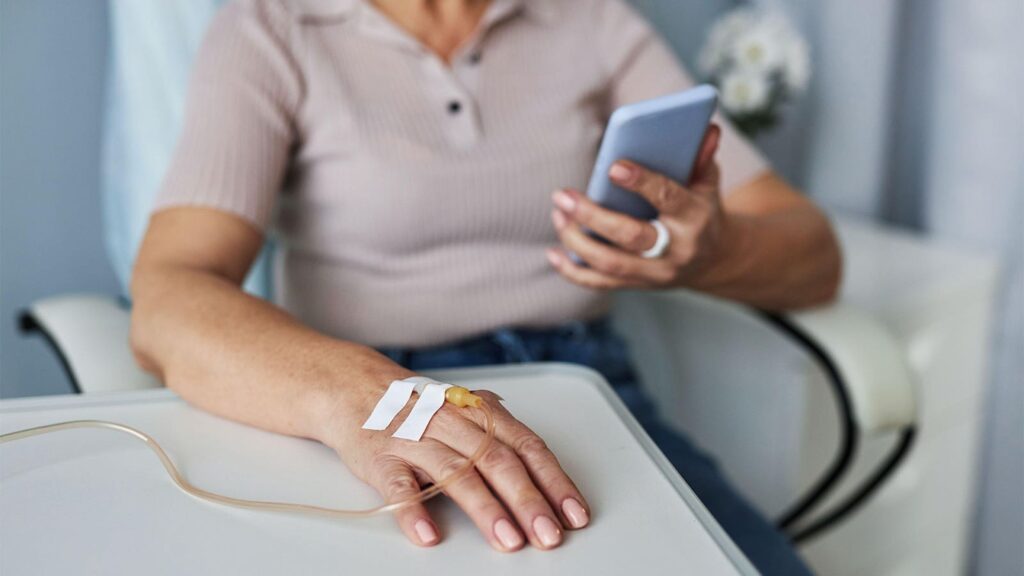Combining chemotherapy with one or two immune checkpoint inhibitors (ICIs) as second-line treatment for advanced gastric or gastroesophageal junction (GEJ) adenocarcinoma failed to improve progression-free survival (PFS) at 4 months, a randomized phase II trial showed.
For patients randomized to FOLFIRI (leucovorin, fluorouracil, and irinotecan) plus durvalumab (Imfinzi) or FOLFIRI plus durvalumab and tremelimumab (Imjudo), neither group reached the prespecified 4-month PFS rate of 70%, with rates of 44.7% and 55.6% in the two groups, respectively, reported David Tougeron, MD, PhD, of Poitiers University Hospital in France, and colleagues.
Median PFS was 3.8 months in the group who received one ICI and 5.4 months in the group who received two ICIs, while objective response rates were 34.7% and 37.7%, median overall survival was 13.2 and 9.5 months, and disease control beyond 1 year was 14.9% and 24.4%, respectively, they detailed in JAMA Oncology.
However, Tougeron and team said that other outcomes — particularly the extended duration of disease control in about 20% of patients taking ICIs — suggested that the regimen “deserves evaluation in a randomized phase III clinical trial comparing FOLFIRI combined with ICIs versus FOLFIRI alone in a selected subgroup of patients with favorable biomarkers that remain to be identified.”
Patients included had disease progression after platinum-based chemotherapy and had not received prior immunotherapy, a main study limitation given FDA’s 2021 approval of nivolumab (Opdivo) combined with oxaliplatin-based chemotherapy in the first-line setting for tumors with a PD-L1 combined positive score (CPS) of 5 or higher, the new standard of care for this patient population.
According to National Comprehensive Cancer Network guidelines, ramucirumab (Cyramza) in combination with paclitaxel (preferred) or as a single agent are category 1 recommendations for second-line or subsequent therapy for gastric cancer. FOLFIRI is a preferred treatment option that can be safely used in the second-line setting if it was not previously used in first-line therapy, and has demonstrated a median OS of 4 to 9.5 months and a median PFS of 2.5 to 5.3 months.
With limited treatment options in the second line, Tougeron and colleagues wanted to evaluate the effectiveness of FOLFIRI plus the PD-L1 inhibitor durvalumab (the FD arm), with or without the anti-CTLA-4 agent tremelimumab (FDT arm).
The authors pointed out that while data suggest anti-PD-1/anti-PD-L1 efficacy depends on a PD-L1 CPS in advanced gastric/GEJ adenocarcinoma, PFS did not vary according to PD-L1 CPS in this study. However, there was a trend toward better PFS for tumors with a PD-L1 tumor proportion score of 1% or higher.
In an editorial accompanying the study, Thierry Alcindor, MD, of Dana-Farber Cancer Institute and Brigham and Women’s Hospital in Boston, said this finding highlights the need for more accurate biomarkers before testing the better-performing arm of the study — those receiving FOLFIRI plus durvalumab and tremelimumab — in a phase III trial.
“In the absence of any putative biomarker of long-term benefit to have been identified in the PRODIGE trial, plans to proceed with a phase III study appear insufficiently justified,” Alcindor said. He further noted that patients are using ICIs combined with chemotherapy earlier in the course of their disease, and promising results have been seen with that combination in the perioperative setting.
“Therefore, it is likely that the question raised by this study will become less relevant, although investigators will probably look at the potential advantage of maintaining ICI while changing the chemotherapy backbone on progression after first-line treatment,” Alcindor wrote.
The PRODIGE 59-FFCD 1707-DURIGAST trial was a non-comparative study conducted from August 2020 to June 2021 at 37 French centers. The researchers included 96 patients (median age 59.7 years, 30.4% women, 53.3% with GEJ tumors) who were randomized 1:1 to the two arms. Median follow-up was 20.3 months in the FD arm and 23.2 months in the FDT arm.
The median duration of response was 6.1 months in the FD arm and 10 months in the FDT arm.
Most patients reported at least one treatment-related adverse event (AE; 93.5% in both arms). Grade 3/4 treatment-related AEs were observed in 47.8% of both arms and included asthenia (17.4% in the FD arm vs 28.3% in the FDT arm), neutropenia (15.2% vs 23.9%), anemia (10.9% vs 6.5%), diarrhea (2.2% vs 10.9%), and vomiting (6.5% in both arms).
Grade 3/4 immune-related AEs were observed in 8.7% of patients in the FD arm and 10.9% in the FDT arm and were mostly diarrhea/colitis. No death was considered treatment related.
Four patients in the FD arm and three patients in the FDT arm stopped treatment due to treatment-related AEs. One patient in each arm stopped durvalumab due to immune-related AEs, while two patients in the FDT arm stopped tremelimumab due to immune-related AEs.
Disclosures
The study was supported by AstraZeneca.
Tougeron reported personal fees from AstraZeneca, Sanofi, Amgen, BMS, MSD, Roche, Servier, and Pierre Fabre.
Co-authors also reported relationships with industry.
Alcindor reported grants from EMD Serono, and personal fees from AstraZeneca, Merck, BMS, and Roche.
Primary Source
JAMA Oncology
Source Reference: Tougeron D, et al “FOLFIRI plus durvalumab with or without tremelimumab in second-line treatment of advanced gastric or gastroesophageal junction adenocarcinoma: the PRODIGE 59-FFCD 1707-DURIGAST randomized clinical trial” JAMA Oncol 2024; DOI: 10.1001/jamaoncol.2024.0207.
Secondary Source
JAMA Oncology
Source Reference: Alcindor T “Immunotherapy in gastric cancer — choosing methods or results” JAMA Oncol 2024; DOI: 10.1001/jamaoncol.2023.7262.
Please enable JavaScript to view the comments powered by Disqus.
Source link : https://www.medpagetoday.com/hematologyoncology/othercancers/109506
Author :
Publish date : 2024-04-04 20:27:18
Copyright for syndicated content belongs to the linked Source.
